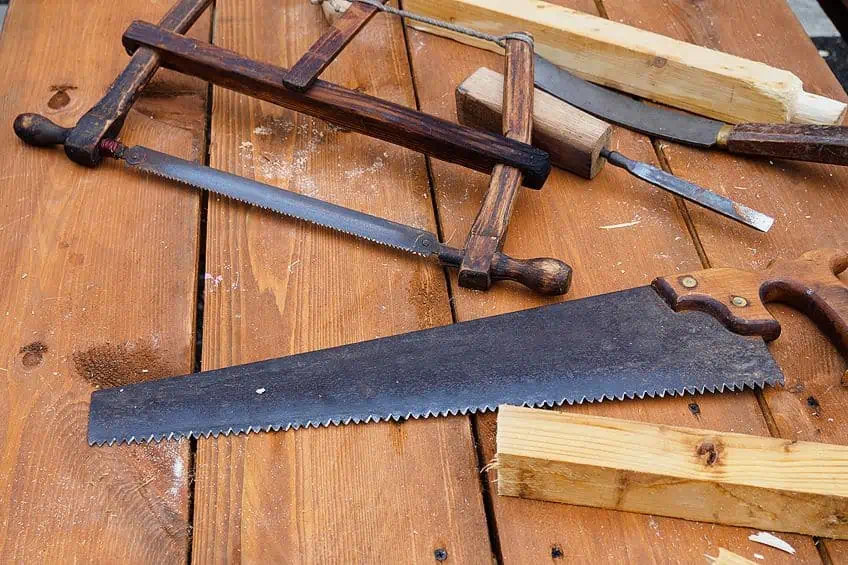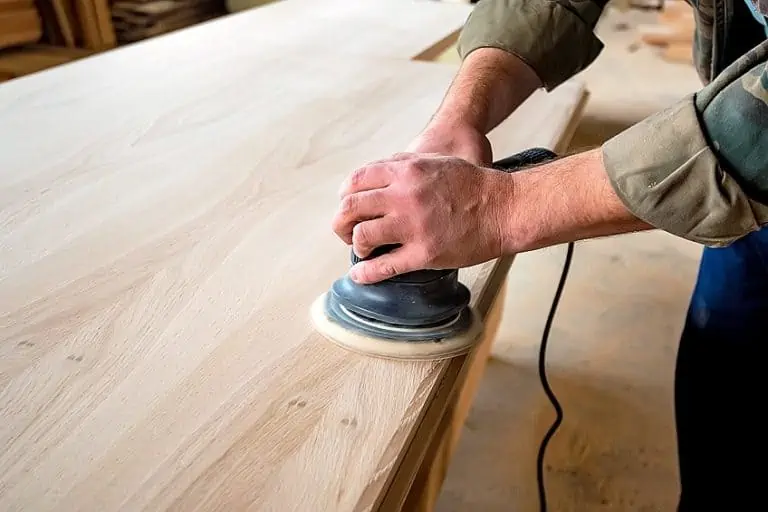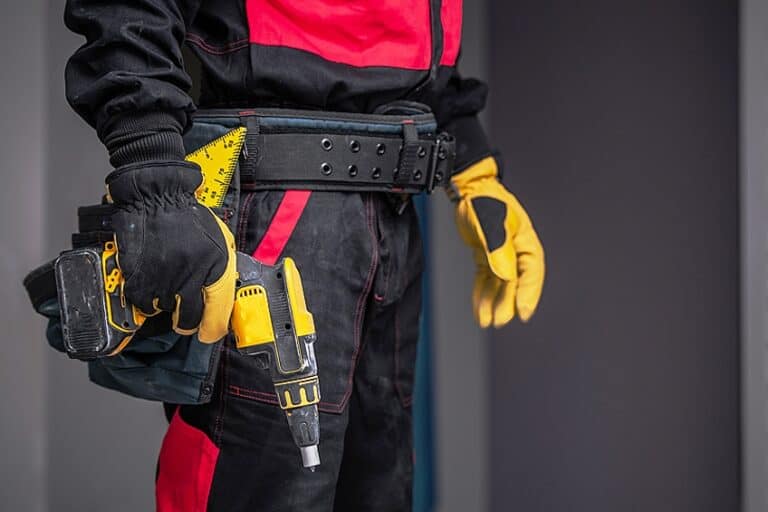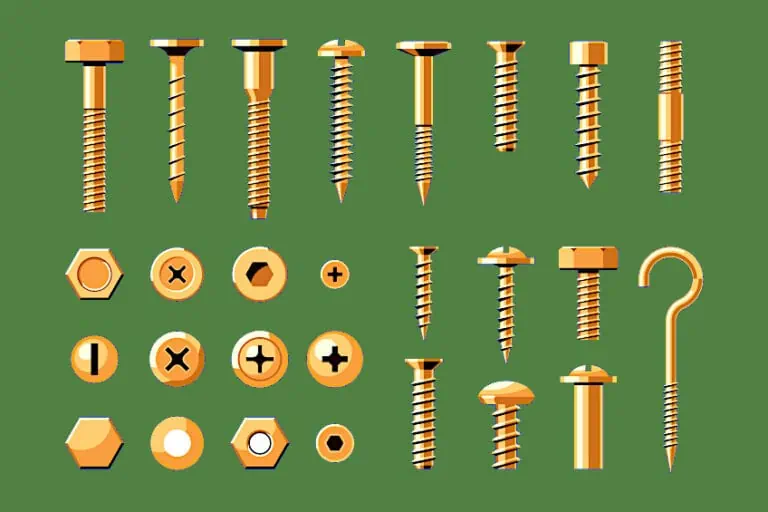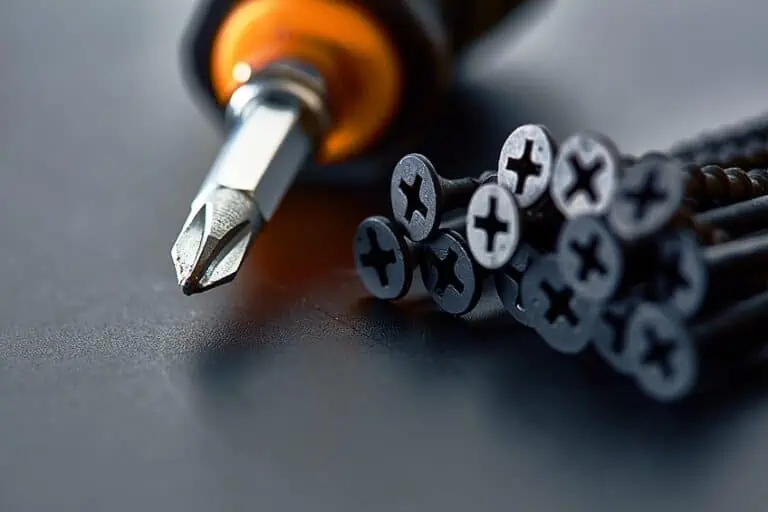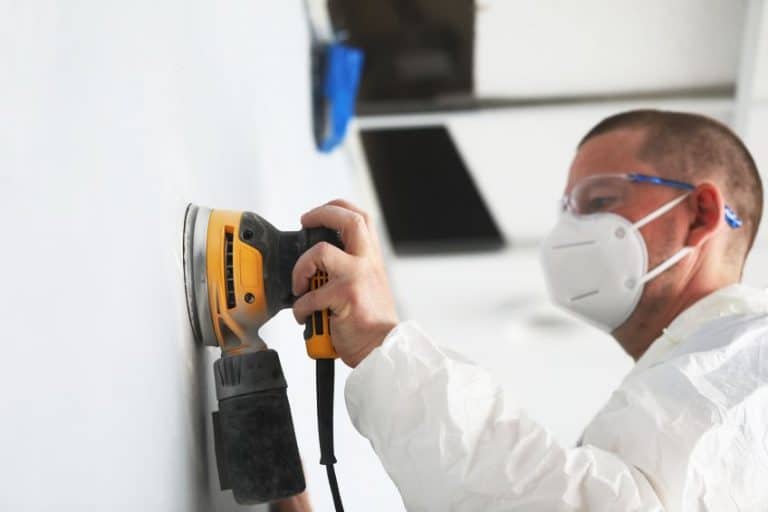Types of Saws – A Comprehensive Look at the Different Kinds of Saws
One of the most fundamental tools ever devised by man is undisputedly the saw. Having a saw in the bronze age or medieval times could mean the difference between living in squaller and having a highly profitable business. Giving the operator the ability to cut through metal, wood, animal pelt and even bone meant having an invaluable skill set you could use to feed your family. This serrated piece of mental still plays a crucial part in our modern lives so let’s learn some more about what they are and where they are used.
Table of Contents
How Many Kinds of Saws Are There?
Well, this depends on the scope of your definition. If we were to cover every saw ever invented or in use today, we could easily fill a good few hardcover books. So, for the sake of simplicity, let us have a look at saws that you would commonly find in commercial or private use. Most people agree that there are 30 variations of the most commonly used saws around the world, ranging from manually operated saws to powered saws. Take a deep breath as we run through these saws!
Manually Operated (Hand) Saws
Hand saws are the bread and butter of any wood craftsman’s arsenal. Manually operated saws are largely responsible for the construction of modern city infrastructure, and are limited by only two things: your stamina and the longevity of the blade. Here are some of the most commonly used hand saw types on the market.
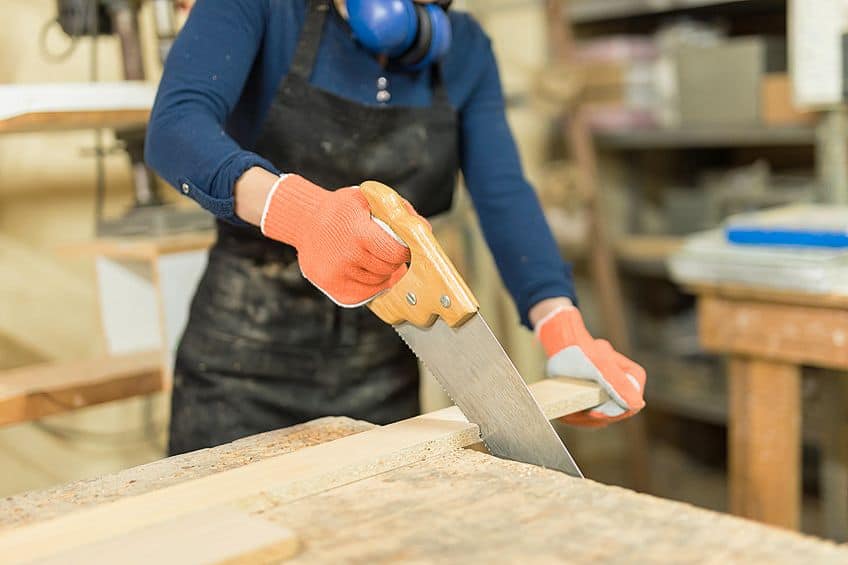
Traditional Hand Saws
The traditional hand saw is like that friend you have known since before you knew how to read. It has changed and grown a little, but it is still fundamentally the same reliable, trustworthy, and effective tool in your collection. Hand saws have evolved from crude cast iron-bladed, wood-handled instruments of torture to the lightweight, ergonomic steel-bladed tools we use today.
Perfect for commercial and home use, the hand saw will (depending on the blade used) cut through everything from aluminum car chassis to tree branches and PVC pipes. This saw is invaluable to every handyman, craftsman, and maintenance supervisor on the planet.
The Fine Saw
A fine saw mostly resembles a rather large kitchen knife and is used in the same fashion. The fine saw has a relatively small blade consisting of many fine teeth which are perfect for clean cuts. You are most likely to clean up dust rather than splinters when working with a fine saw.
In fact, the teeth and width of the saw’s blade are so fine that they are often used to saw through wooden pegs with such proficiency that the surface is left virtually flush even before it is even sanded down.
Although the blade is definitely a key piece of this saw, the fine saw’s handle is also pretty special. The handle tapers outward from the blade, resembling a deformed rolling pin in some instances, and can be gripped overhand or underhand for the operator’s convenience. These handles have evolved from wooden handles, which wore easily, to synthetic grips which are far more ergonomic and durable than their predecessors.
The Bow Saw
One of the key tools in the landscaping trade, the bow saw is the perfect tool for rearranging nature to your liking. Whether you’re felling medium-sized trees or pruning the branches of a great oak, the bow saw has you covered. The C-shaped clamp allows for a massive berth between the serrated blade and the frame of the saw, meaning that you can cut deeper than you could ever dream of with a conventional hand saw.
The teeth of the bone saw also allow for debris to be removed during the cutting process. In fact, rather large bow saws are so sturdy they have been used to cut down massive trees close to 100 years old, although it is worth mentioning that it takes two people on both ends to operate a bow saw of this size.
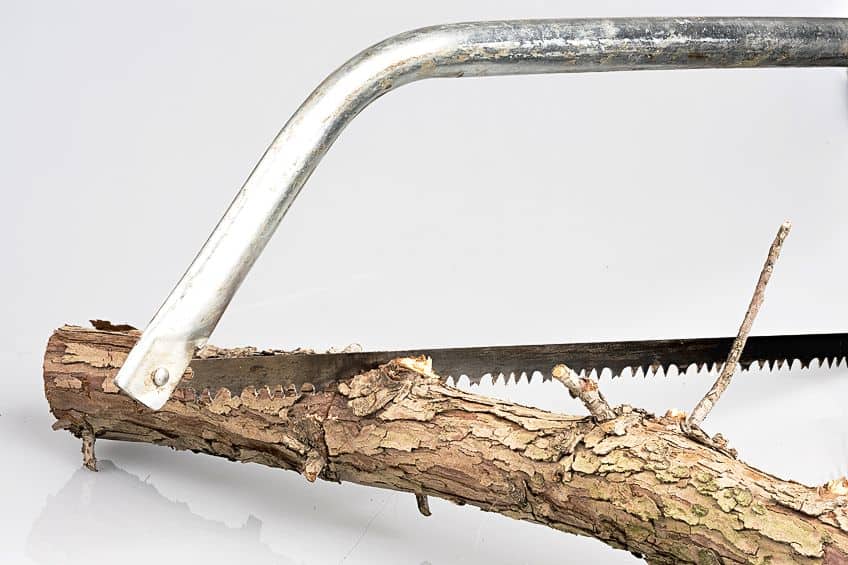
The Fret Saw
Used in professional woodwork environments, the fret saw is one of the less commonly owned saws on this list. The fret saw is unique, characterized by having a rather deep C-shaped frame that forms quite the distance between the back of the blade and the apex of the frame, and rightfully so considering it is used for cutting intricate workpieces.
The fret saw’s blade might not be directionally adjustable, but it does have the ability to bend just enough for you to be able to comfortably cut at even the most awkward angles. The fret saw is most at home when working with intricate workpieces, so furniture and wood craftsmen will find it particularly useful.
The Coping Saw
Think of the coping saw as a watered-down version of the fret saw. While the C-shaped frame of the fret saw is extremely deep, the C-shaped frame of the coping saw is much shallower, which means that it isn’t able to cut as deeply or as intricately as the fret saw.
This is a good tool to keep around and in fact, many people do just this, making the coping saw a bit more commonly found in the average crafter’s workspace than the fret saw. Featuring the same tooth size and distance as the fret saw, owning a coping saw is one of those “just in case purchases,” as most of us don’t cut intricately enough to warrant owning a full-on fret saw.
The Hacksaw
One of the most recognizable hand saw types in the world, the hacksaw is about as synonymous with woodwork as Oreos are with the word “cookies”. Even if you have never touched a piece of wood in your life, you are probably well aware of the hacksaw and its uses.
Featuring replaceable blades of varying tooth counts, materials, and strengths for countless applications, the hacksaw finds its place anywhere someone needs something cut up.
A hacksaw can be used as a wood saw, but it can also be used to cut plastic, metal, material, ice, plant stems, and (although not condoned or recommended at all) it can even be used to cut through bone and thick animal hide. This is due to the wide variety of blades available for the hacksaw.
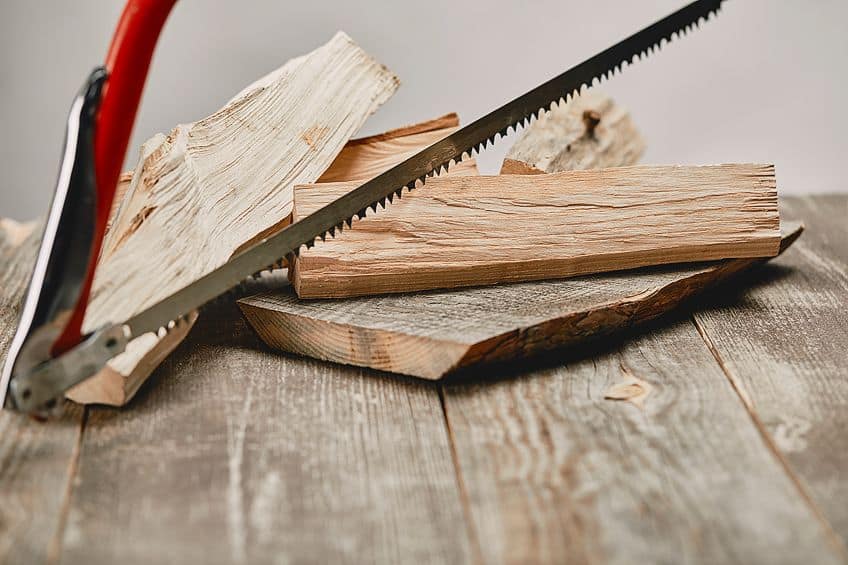
The Japanese Saw
The Japanese have proven over and over that the ability to innovate and improve upon existing technologies can often change the way we live our lives. From cars to information technology, their ingenuity has had a significant cultural impact not only in their own land but around the world. The Japanese saw is no exception, possessing every bit of the precision and ease of use you would expect.
The saw is characterized by having a relatively long, thin, finely toothed blade capable of cutting with brilliant precision. The handle of the blade is much longer than you would expect, making it resemble a flangeless spatula. The combination of the long, thin blade and even longer handle means that you can access those nooks and crannies that would otherwise be unreachable.
The Keyhole Saw
This one is pretty self-explanatory in its purpose. The keyhole saw is used to roughly cut holes in surfaces. The keyhole saw is characterized as having a blade that is finely toothed, where a fine point tapers from the tip to roughly the size of the saw’s handle.
These saws are not commonly found as their function is pretty specific, and therefore, they are mainly used commercially in contrast to some of the other saws on this list.
The handle of the keyhole saw resembles that of a kitchen knife; in fact, the entire saw could easily be mistaken for a de-boning knife if you were to catch it at a glance. It is functionally the same as well, being used to penetrate and cut simultaneously, and it even makes a good wood saw for smaller workpieces.
The Frame Saw
Out of all of the saw types we have covered so far, the frame saw is one of the more visually intriguing models. This saw is characterized by having a wooden frame in the shape of the letter H, featuring a blade on one of the open ends of the frame and a threaded locking mechanism on the other, which allows you to change the blade without the need for a screwdriver or wrench.
This saw is as versatile as they come, being used for any number of purposes, although since the tip of the blade is extremely sharp, it is primarily used to remove unwanted materials, trim the edges of workpieces, or cut fine lines. The shape of this saw provides unique ergonomic advantages when compared to other saw types, and even though it provides all these advantages, it is still largely unknown by most craftsmen.
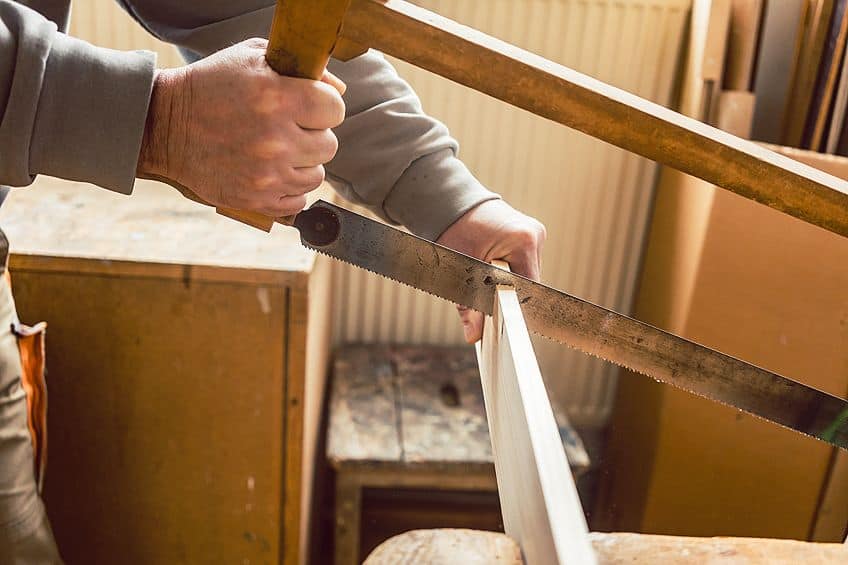
The Pruning Saw
If we are going to be looking at niche saws, we would be remiss if we didn’t mention the pruning saw. As the name suggests, this saw is designed for the professional landscaper, allowing you to prune, shape, and cull vegetation as you see fit. The pruning saw is characterized by having a long blade of medium thickness and narrow width.
The blade is attached to a curved handle resembling that of an old Colt revolver, allowing you to operate the saw with one hand, give the pruning saw the appearance of a small sword rather than a wood cutting instrument.
As we covered previously, this saw fills a very niche market, so it is not very common in the average workshop.
Power Saws
Power saws are driven by electric motors that power gears or pulleys which reciprocate the blade back and forth, thus eliminating the need for you to move the blade back and forth on your own. This not only saves you some elbow grease but saves you time as well. Let’s have a look at some popular power saw types, their strengths, and their applications.
The Band Saw
This type of saw can be found in both commercial and private environments, which is no surprise considering the versatility and power this type of saw provides. The band saw is characterized as a cutting table with a blade attached to an overhead motor, which is attached to the table via a pillar.
This type of power saw can be used to cut and score various materials, making it invaluable to commercial industries and weekend craftsmen alike. Although they can be expensive to purchase initially, if you have the workload that warrants buying this type of power saw, it will earn its keep pretty quickly.
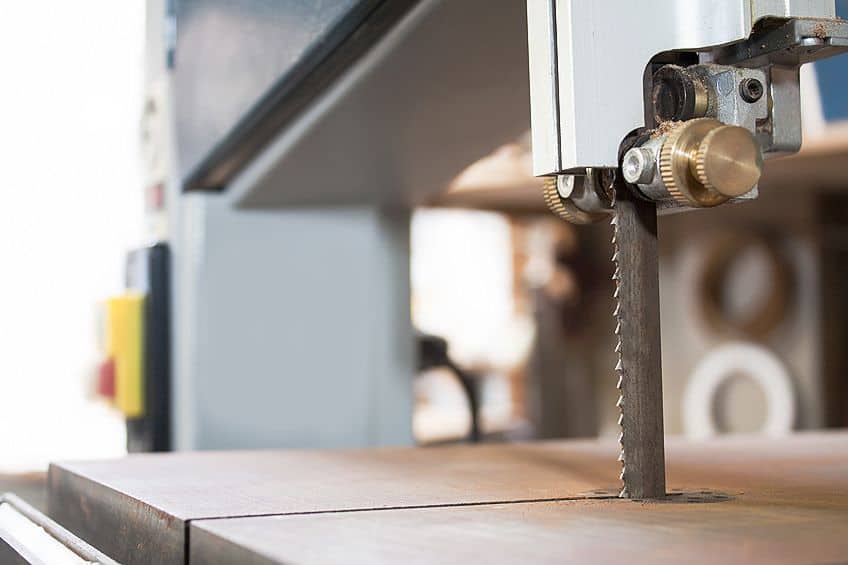
The Jigsaw
Jigsaws are easily identifiable and are one of the more common power saw types on the market today. Jigsaws are a common sight in the workspaces of most weekend warriors, which comes as no surprise considering the level of precision and versatility that these saws provide.
The jigsaw is characterized by a hand-held rectangular unit housing a motor and driver train with a reciprocating blade protruding out of the other end.
Most Jigsaws also have a hammer function, meaning that as the blade reciprocates, it also moves back and forth, which is especially useful when cutting through drywall and plywood. These saws aren’t the most powerful units available, but they are extremely versatile with lots of different blade composites available. You can think of the jigsaw as the powered counterpart to the trusty hacksaw.
The Alligator Saw
The alligator saw is one of the less common saw types we have on this list. You might have noticed that it resembles the chainsaw in appearance, but the similarities pretty much end there. Instead of a rotating chain of teeth, the alligator saw uses two serrated blades that rapidly move back and forth past one another, which creates the cutting motion.
These saws are relatively powerful although they are not as robust as chainsaws, and have the added advantage of being powered by a cord or battery. It is a good saw for cutting wood, but you won’t find it in the middle of a forest cutting down trees. The alligator saw is good at cutting through composite building materials and even some metalsm although it can be difficult to find blades conducive the cutting through various alloys.
The Chainsaw
The chainsaw needs little to no introduction. Featuring a large, toothed chain that has specially designed hooked teeth for cutting through virtually anything, the chain saw has been featured as various horror movie villains’ weapon of choice. The power of a chainsaw can vary, as there are various grades of teeth available for this saw.
The chainsaw is most at home cutting through large tree stumps like a knife through butter, making the work of four full-grown men seem effortless. Chainsaws vary in power depending on the output of the motor, and can be powered by diesel, gasoline, or even a series of batteries in some instances. The chainsaw is arguably the best saw for cutting wood in forested areas. Do you know why chainsaws were invented? That was really shocking to me.
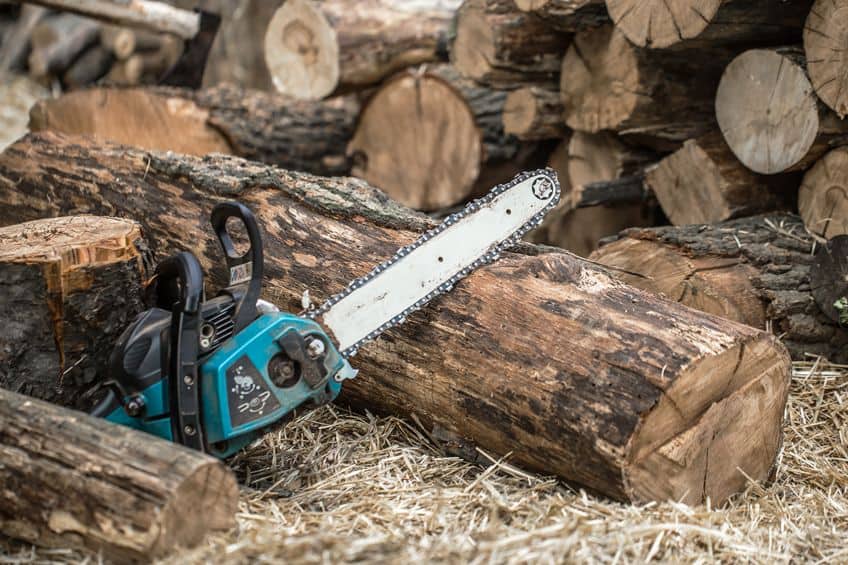
The Chop Saw
The chop saw can be found in the workspaces of recreational and commercial craftsmen. The device itself is quite simple, characterized by a circular blade attached to a small cutting board by a flange. The flange, and by extension the blade, can be raised and lowered while the blade is rotating, reminiscent of meat saws in a butcher’s shop.
The saw can be used to cut a variety of materials; in fact, chop saws in engineering environments are capable of cutting through various metals and even concrete. In an effort to reduce heat conduction to the blade when cutting metal or concrete, a tube that dispenses cutting fluid is often added to these kinds of saws.
The Saber Saw
The saber saw can be a contractor’s best friend. Powerful and robust, the saber saw is capable of cutting intricate shapes through tough material, which means that it is often used to cut drywall to suit unconventional spaces such as staircase bases.
This saw is characterized by its handheld grip containing the motor and the blade – it closely resembles a drill with a reciprocating blade instead of a drill bit.
Blades for this power saw come in a wide variety of composites and, combined with the outstanding power of the saber saw, are capable of cutting through virtually anything. The use of this saw does present some difficulties, however, as in order to provide sufficient power to the motor, this saw is not battery powered and will require a fixed connection to the main power supply. This is because generators can be overtaxed by the saw’s output requirements.
The Circular Saw
The circular saw is one of the most commonly used saws in the carpentry industry. This saw has a simple design consisting of a vertical blade powered by a motor, which is integrated into a handle attached to either the left or right side of the rotating blade.
This saw is popular in general use and is used to cut through large and small pieces of wood. Although it is not very powerful, its output is more than adequate for a number of applications. The circular saw, like most power saws, has a wide variety of blade composites available for cutting through many materials such as stone, plastics, and even metals.
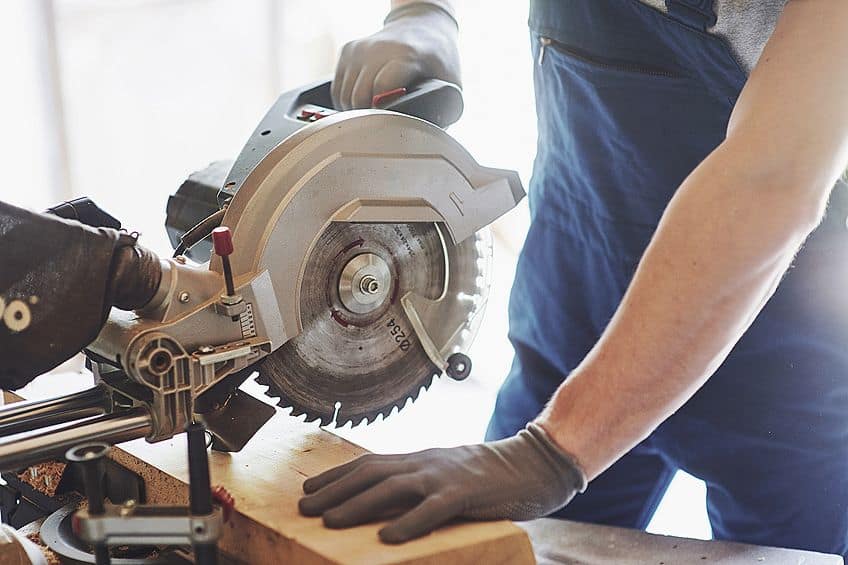
The Reciprocating Saw
The first of its kind to feature the reciprocating motion, this saw has paved the way for a number of saws that feature the same action. This saw is essentially a handheld unit in which the main housing contains the electrical motor and the reciprocating mechanism.
The blade is long, sharply toothed, and can be used to cut through several materials. Although not extremely powerful, this tool is useful in all kinds of trades from engineering to carpentry and even baking. These saws can be battery powered, but typically they are powered by an outlet.
The Flooring Saw
The flooring saw is special, even by the standards of this list. The flooring saw is characterized by looking much the same as the chopping saw we covered previously, also featuring a cutting table with adjustable chucks and a saw that can be raised and lowered onto the material you intend to use it for.
The flooring saw is special because it is specially designed to cut through flooring material, meaning that it can cut through hardwood, laminate, and even tiling, should you have the correct blade.
This type of saw is extremely niche and will typically be found in the back of a flooring contractor’s van along with some tile sealer and a variety of blades. Due to the power output of this floor’s motor, these saws are not battery powered and need to be plugged into an outlet.
Table Power Saws
These kinds of saws fit into very niche environments and, unless you are doing work conducive to using these types of saws on a daily basis, you probably don’t need one, although they are quite nice to have around should the need arise. Let us have a look at these kinds of saws, their make-up, and where they are commonly found.
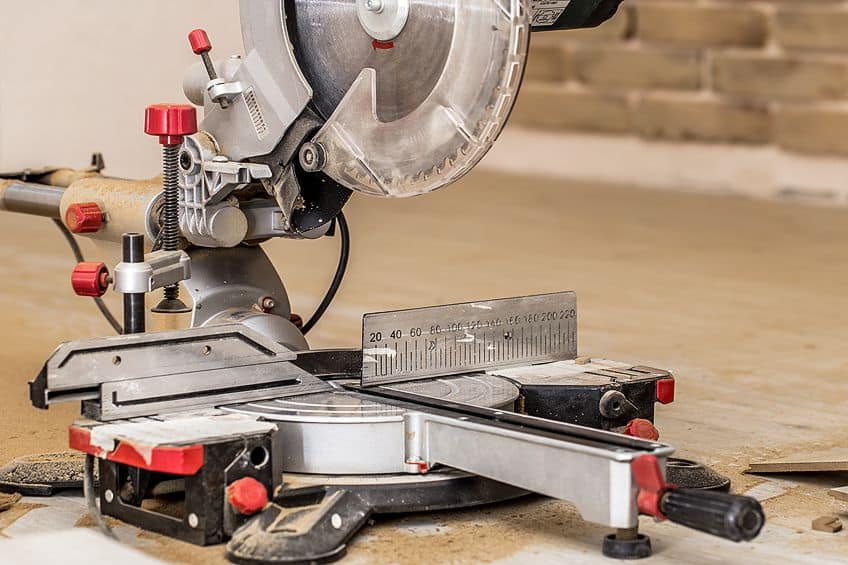
The Panel Saw
The panel saw is most commonly found in the lumber industry. This saw can be positioned in either a vertical fashion or horizontally like a table. The blade of this saw does not move, which means that you need to feed the material you are cutting towards the blade for it to be cut. These types of saws are also large, so you will need a fairly big, well-ventilated area to operate and store it in.
These types of saws are most commonly found in the tree felling industry to cut and process large pieces of timber, such as cutting entire tree stumps in half about as easily as one would tear a piece of paper in two. They are mostly found in commercial industries as there is not much use for a saw of this size and output in the home of the average craftsman.
The Table Saw
The table saw is the bread and butter of any woodwork environment. This type of saw is so versatile and so commonly used that it is hard to imagine the industry without it. In fact, before they were mass-produced for commercial use, craftsmen often made their own table saws by repurposing chop saws and circular saws and integrating them into a table for cutting larger materials.
Units that you can purchase today have a sprawling catalog of add-ons such as larger chucks, tables with pre-drawn measurements, pockets that catch sawdust and cut-offs, and even laser-assisted guidance.
Although these units are fairly large and can’t be easily transported, they make up for this in power and versatility. There are a variety of blade composites available for table saws that are capable of cutting through metals, wood, plastic, and even ceramic materials. One of the downsides of this type of saw, however, is that it is only capable of cutting in straight lines and therefore won’t be conducive to cutting intricate shapes.
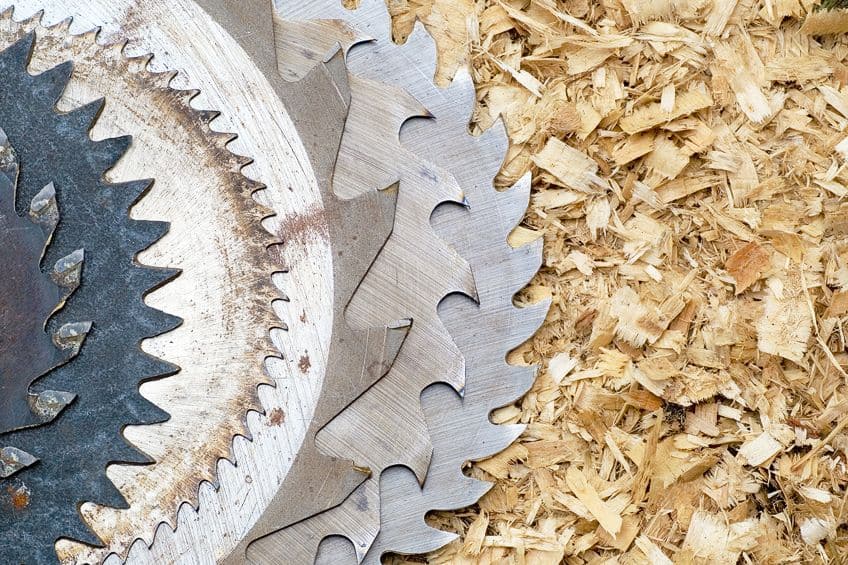
The Miter Saw
The miter saw is essentially a table-mounted version of the circular chopping saw. This saw consists of a small base that can be bolted to a workbench. This base has a vertical flange attached at one end that suspends a circular blade covered by a half guard. This saw is distinct as unlike the chopping saw, it has the ability for the blade to be tilted to a 45-degree angle as well as the conventional 90-degree angle, allowing you to cut and trip your workpiece at these angles.
This type of saw is innovative and generally comes out of the box with a premium finish, which is no surprise as the costs a bit more than other saws in their class. This saw can be found in both home and commercial environments, but is usually used on smaller workpieces for more intricate finishing work.
The Multi-Blade Saw
This saw most certainly will not be found in someone’s home. This saw consists of multiple blades that will shred through virtually anything you put into it. Most multi-blade saws have you feed your workpiece into it via a set of rollers – whether it be tiling, wood, metal, or even plastic – and it will cut through them like they are absolutely nothing.
These saws range from medium to absolutely massive, and are designed for high-volume, fast-output environments such as furniture factories and wood processing plants.
The blades of these saws are interchangeable, although it can be quite the undertaking to actually change them out. In fact, it is best to have two people perform the task if the matter is time-sensitive. There is also a fair amount of safety risks in operating this type of saw, as the rollers and blades are extremely powerful compared to any other saw we have covered thus far.
The Radial Arm Saw
The radial arm saw is another highly specialized machine that can be pricey if you are thinking about buying one. This saw consists of a bed that can be attached to a workbench. The blade is attached to the table via a two-point hinge, which is capable of moving on a Y-axis both toward you and away from you, as well as up and down. This saw can be used to create deep cuts or can be used to trip workpieces.
You will need a fairly large workbench to accommodate this type of saw, meaning that they are usually used for commercial purposes rather than home use. This saw is extremely powerful and, like other commercially used saws, comes with many blades of varying composites for cutting through virtually any material you could think of throwing at it.
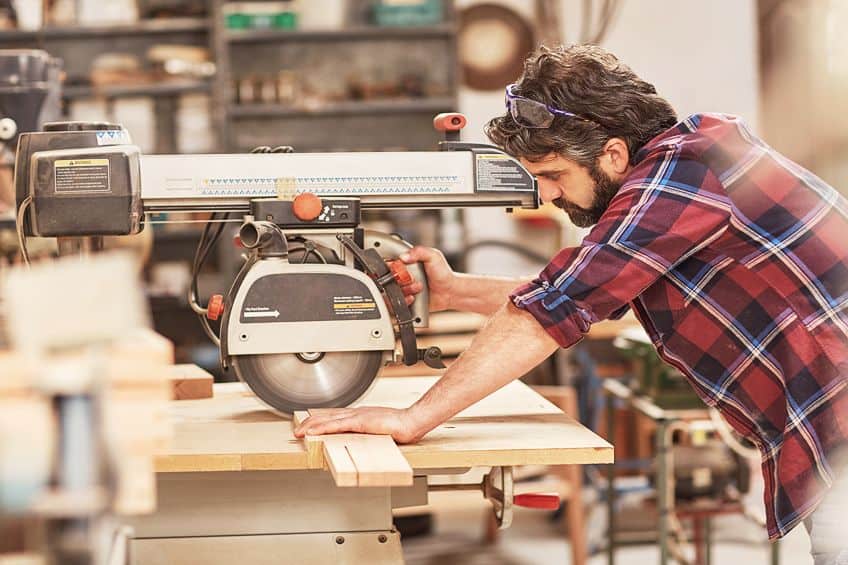
The Scroll Saw
The scroll saw is almost exclusively used by woodwork designers and carpenters. These kinds of saws are capable of cutting and coring intricate patterns and shapes both into and out of a piece of wood. Due to their niche purpose, these saws are not commonly found in most commercial or private workshops as they can’t be used for much else.
The scroll saw consists of a base that can be mounted to a workbench and is relatively light compared to the other saws on this list. Attached to the base via an L-shaped arm is the motor and blade, which are suspended vertically over the base. You then move your workpiece towards the blade in accordance with the shape you would like to produce.
The Tile Saw
We have covered the handheld version of this saw previously, however, this tile cutting saw gives you a bit extra. Featuring its own independent workbench and integrated circular saw, the tile saw is used to cut ceramic tiling specifically, even enabling you to cut round-edged tiles.
The tile saw’s table features a number of chucks and measurement metrics, thus making cutting easier and more precise than having to mark your tiles and/or hold them by hand.
Some tile saw models have the blade raised and even slightly adjustable for when you are working with slightly thicker tiling, and the table of the unit is often collapsible and portable for contractors who are moving from site to site and need something a bit more robust than a handheld saw.
Specialty Saws
These are the saws that were a bit too obscure to be included with the main saws we covered previously, and you should count your lucky stars if you just so happen to come across one. Let’s have a look at some of the lesser-known saws on the market today and what they are used for.
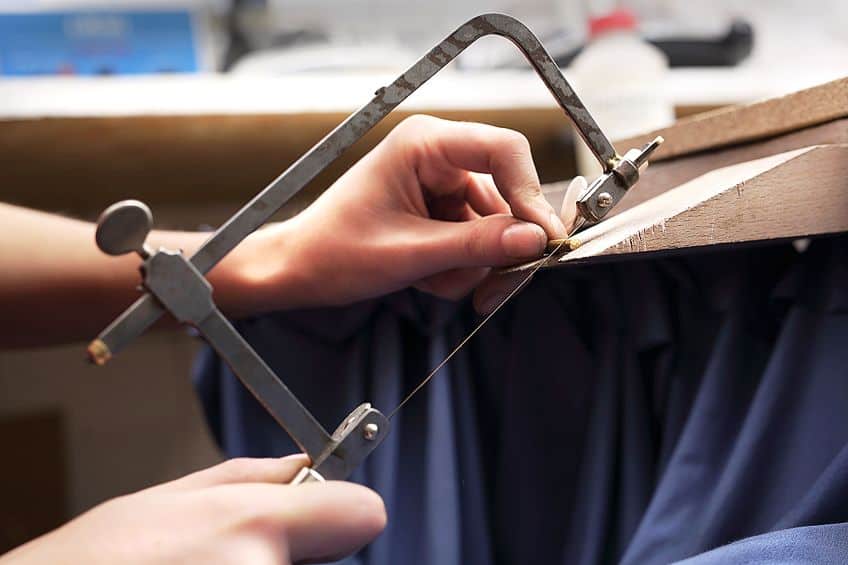
The Veneer Saw
The veneer saw is small and resembles the common box cutting knife in its stance and application. The veneer saw is characterized by its rectangular finely toothed blade, which is attached via an offset to a typically wooden handle.
It is issued to cut veneer, which is a thin wooden material used as a backing on covering for more sturdy materials. Like dentistry tools, this saw is highly specialized and won’t typically be found at your local hardware store.
The Wire Saw
A very obscure and a bit odd to even be considered a saw, the wire saw consists of two rings connected by a single piece of serrated wire. Like the veneer saw, it is obscure and is operated manually by forcing the serrated wire back and forth on the material you intend to cut.
The wire saw can also be used to create a bow saw by attaching the wire to the stick and forming a bow with the two objects.
This saw is sharp and can be used to cut through materials such as hardwood and even rock, depending on how ambitious you are how much elbow grease you intend to use. This is a great tool to have in survival situations as it is easily stored and quite versatile in its applications.
The Pole saw
The pole saw is more likely to be found in a gardening store than a hardware store. This saw is quite odd in its appearance, featuring quite a long handle and a short blade for trimming hedges and hard-to-reach branches in your beloved garden. The blade is relatively large-toothed and is often made with protective coatings to avoid rust, since they are usually stored in sheds.
This saw does not have any intended application outside of gardening and landscaping, and based on the size of the blade, we don’t suggest trying to use it on anything else. This is purely in the interest of preserving the blade, as not much harm can be done to you with this particular saw.

Safety Tips for Using Power Saws
Before using a saw – power saws, in particular – there are minimum safety requirements that one needs to follow in order to avoid injury. Here are some precautions you should follow when operating a power saw in any environment.
Dress Correctly
When you are using a power saw, you should always be dressed appropriately. Much like drill press safety protocols, you should always wear gloves when operating a power saw. This is not only to prevent you from injuring your hands, but it allows you to have a greater grip on the handle of the saw and a greater ability to regulate its speed.
Eye protection is also extremely important, as splinters and sawdust become projectiles at high speeds, and one entering your eye will undoubtedly cause permanent damage to your vision and depth perception.
Some machines are sold with safety goggles and face masks to prevent sawdust and splinters from entering your eyes and lungs, although if your particular model does not, you can purchase appropriately graded eye and face protection from most hardware stores.
Adhere to Safety Guidelines
Safety is of utmost importance when dealing with any power tool. These machines can be extremely dangerous when handled incorrectly and can result in you losing a few digits, an entire limb, or even the loss of life if you do not follow appropriate safety guidelines while operating them. These guidelines are included with must machinery and pertain to both your own actions and the operation of the machine.

Your Safety
When it comes to your own behavior, there are a few things you should never do. If a power saw comes equipped with a safety guard it should never be operated without the use of the guard or with the guard being attached in a manner that is unsafe or in a damaged condition. When servicing a power saw, you should ensure that there is no power to the unit and that all electrical wiring is properly insulated and stored so that it cannot be stripped or frayed by surrounding objects or foot traffic in the area.
Machine Safety
Pertaining to the operation of the machine, you should never operate a machine without a safety guard. You should also be aware of the tolerances of the machine and never exceed the said tolerances of the blade or the motor powering the blade. Be aware of materials that your saw can and cannot cut through, as cutting through materials that your blade or motor is not graded for can result in damage to your unit and blade.
Almost all modern table saws are equipped with an emergency safety stop for emergency situations – these safety stops should be checked regularly and should be unobstructed in your work environment. You should also be aware of the condition of your saw blades, as using a dulled or fractured blade can result in both damages to your workpiece and unit, not to mention that fractured blades can splinter at a high RPM, becoming projectiles that could fatally wound you and those around you.
Now that you are aware of all of the saws available to you, it probably seems that there is nothing capable of escaping your cutting power. Remember to always consider the kind of work you will be doing when choosing a saw and always keep safety practices in mind when operating any manual or electrically powered saw.
Frequently Asked Questions
What Is the Function of a Power Saw?
A power saw is an electrical saw used for the cutting of wood, plastics, ceramics, and metals. These saws are powered by electrical motors which power reciprocating blades, circular saws, and serrated chains in order to cut through materials. They are generally used to cut through large workpieces and are faster and more effective than manual saws.
How Do You Store a Power Saw?
A power saw consists of both static and electronic components, both of which are susceptible to moisture and oxidization. It is best to store these units in a cool, dry place and somewhere where their sharp edges won’t be a hazard to you or those around you. Many choose to store their power saws on hooks or latches in sheds, whereas others opt for storage chests to eliminate the possibility of the machine falling and getting damaged, or of course hurting someone else.
What Type of Saw Should I Buy First?
This does depend on what kind of work you will be doing. A good first saw is always a conventional hacksaw, as it is versatile and robust enough to accomplish basic tasks. If you are considering getting your first power saw, you should consider a jigsaw as it is easy to use, simple to maintain, and will present a fairly gentle learning curve.

I have been into woodworking since 2005 and woodturning since 2011. Because of my love for wood and woodworking, I started woodhappen.com to teach other enthusiasts about how to finish and seal wood, the best woodworking tools, the different types of wood, and everything else related to woodworking! Read more about me here.

